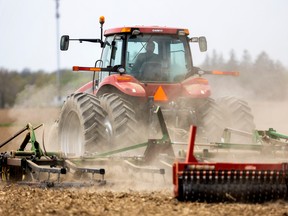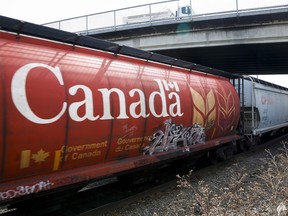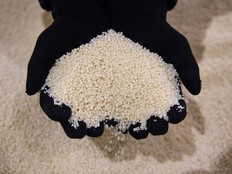Article content
The federal government will spend $34.1 million to compensate Eastern Canadian farmers for a spike in production costs last year due to Ottawa’s decision to impose tariffs on Russian-made fertilizers, according to the 2023 federal budget.
The government slapped a 35 per cent tariff on imports from Russia — a major fertilizer producer — in response to the invasion of Ukraine in early 2022. Finance Minister Chrystia Freeland said the government collected $34.1 million in tariffs on Russian-made fertilizer between March and the end of June last year.
Advertisement 2
Article content
Article content
Farm lobbyists have been pressuring the government to give that money back. The call for “immediate financial relief” from fertilizer tariffs was at the top of the Canadian Federation of Agriculture’s 15-item wish list for the budget, which the group submitted to government last month.
“I’m glad they’re not keeping it and they’re giving it back, because we paid it and we never should have,” said Keith Currie, the federation’s president.
But that payback won’t come in the form of direct compensation for farmers impacted by the tariffs. Instead, the federal budget, released on March 28, proposes to contribute $34.1 million to the Agriculture Department’s On-Farm Climate Action Fund. The money will support “the adoption of nitrogen management practices by Eastern Canadian farmers, that will help optimize the use and reduce the need for fertilizer,” according to the budget. The government billed the new funding as “supporting farmers for diversifying away from Russian fertilizers.”
Advertisement 3
Article content
The program is targeting Eastern Canadian farmers because they depend on imported fertilizer. “Western Canada produces enough nitrogen for the entire country but Eastern Canada can bring it in cheaper by boat from Russia than we can bring it from Western Canada,” Currie said ahead of the budget.
Inflation relief
Farmers have blamed tariffs for driving major increases in farm input costs, which in turn fuelled food inflation. The budget also promised relief from those higher food prices, with $2.5 billion in one-time grocery rebates that would provide low- to modest-income households with up to $467 for a family of four, and up to $234 for single adults.
Some lobbyists say the $34.1 million won’t be enough to fully make up for the Russia tariffs. In the first half of 2022, fertilizer costs jumped by about 82 per cent compared to the same period in the previous year, according to Statistics Canada’s farm input price index.
Article content
Advertisement 4
Article content
Fertilizer Canada, a lobby group that represents importers, producers and retailers, said ahead of the budget that $34.1 million doesn’t represent the full cost to the industry. Some importers cancelled their contracts with Russian producers after the government imposed tariffs, but still had to find other contracts for fertilizer on short notice in a tight global market, leading to extra costs, spokesperson Kayla FitzPatrick said.

Government policy around fertilizer has become a touchy subject in the agriculture sector in recent years. On top of the tariffs, the government has signalled that it wants to reduce emissions from fertilizers by 30 per cent by 2030. Farmers and lobbyists feared that any sort of mandatory reduction in emissions would force them to use less fertilizer, which would cut crop yields.
Advertisement 5
Article content
Prime Minister Justin Trudeau made a surprise appearance at the CFA’s annual general meeting in Ottawa earlier this month, where he reassured farmers that any government policy to reduce emissions won’t be mandatory.
“There’s a lot of disinformation and misinformation you may be reading online that’s adding to your worries,” Trudeau said. “We are consulting with farmers and the industry about a voluntary, not mandatory, reduction in emissions from fertilizers, not in use of fertilizers.”
Trudeau said the plan is to find ways to use fertilizer more efficiently, but stressed that Canada’s agriculture sector can’t afford a cut in yields. “The world needs to be able to have reliable sources of grain,” he said.
Advertisement 6
Article content

Canada’s role as a major global grain exporter took on more importance last year in the aftermath of the war in Ukraine, amid concerns that the conflict would impact crop production and exports from the region. Despite pressure to “feed the world,” Canada’s rail infrastructure was initially slow to get grain shipments to ports and into global markets following a bumper harvest in the Prairies last fall.
Supply chain fix
Trudeau told the CFA that the delays risk undoing the government’s work on free-trade deals around the world and vowed to do more to establish “reliable” shipping and processing for Canadian crops.
“We’ve seen it time and time again where we work really, really hard to develop new markets and then a year or two in, there’s a jam in the system and they turn away for another market and will never come back to Canadian produce,” he said. “That’s why we’re continuing to invest in transportation infrastructure.”
Advertisement 7
Article content
For some of the industry’s top leaders, however, infrastructure spending isn’t the problem. John Heimbecker, the head of Parrish and Heimbecker Ltd., of one of Canada’s top grain exporters, said last year that the real issue is bad government policy and power imbalances in the rail system, which is currently controlled by two companies, Canadian National Railway Co. and Canadian Pacific Railway Ltd.
The national supply chain task force, assembled by Transport Minister Omar Alghabra last year in response to the war, recommended in October that the government implement immediate policy changes that could speed up shipments by injecting more into the railway industry. Specifically, the task force wanted Ottawa to expand a concept in federal transport law known as inter-switching.
Advertisement 8
Article content
If a grain shipper’s facility is on a CN line, but that line intersects with a nearby CP line, federal rules dictate that CN has to bring the shipper’s freight to the CP line. As the rule is written now, the interchange has to be within 30 kilometres of the shipper’s facility.

In the budget, the government said it will introduce legislative changes to temporarily extend inter-switching zones in the Prairies as part of a pilot project to “support competition among rail carriers.”
The government will also spend $27.2 million over five years to set up a Transportation Supply Chain Office that will work with industry to “respond to disruptions and better coordinate action to increase the capacity, efficiency, and reliability” of supply chains across Canada.
• Email: jedmiston@postmedia.com | Twitter: jakeedmiston
Budget 2023: Ottawa promises to compensate farmers for Russian fertilizer tariffs
2023-03-28 21:52:44










Comments
Postmedia is committed to maintaining a lively but civil forum for discussion and encourage all readers to share their views on our articles. Comments may take up to an hour for moderation before appearing on the site. We ask you to keep your comments relevant and respectful. We have enabled email notifications—you will now receive an email if you receive a reply to your comment, there is an update to a comment thread you follow or if a user you follow comments. Visit our Community Guidelines for more information and details on how to adjust your email settings.
Join the Conversation